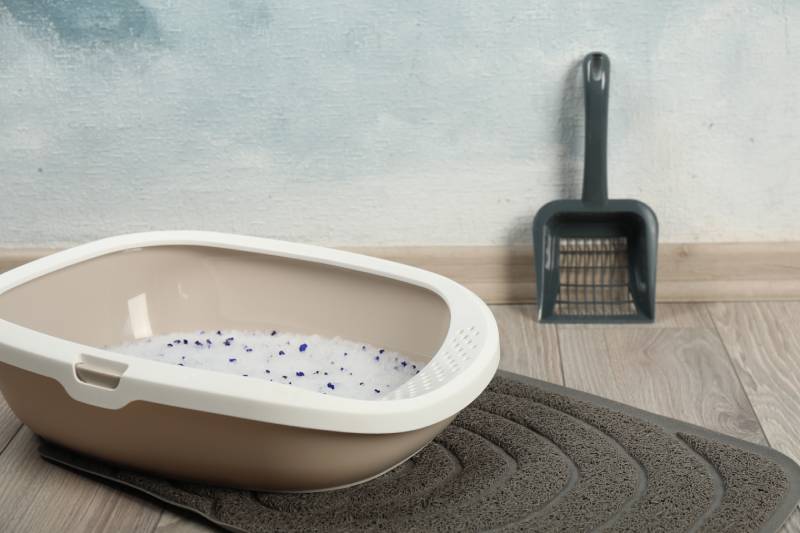Is My Cat Fat or Pregnant? Vet-Approved Ways to Tell (With Pictures)
Updated on
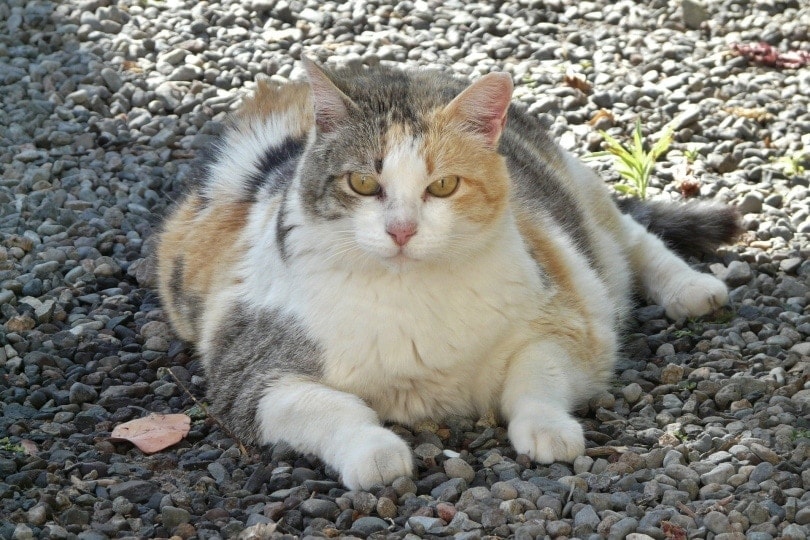
If you’ve started to notice that your cat is a little more plump than usual and you’re wondering if you should cut back on the cat treats or if she might be pregnant, there are some signs that can tell you either way.
We’ll go over the common signs of a pregnant cat—these signs are both physical as well as a change in temperament. We’ll also go into how to take care of your pregnant cat best and how you can tell when she’s about ready to give birth.
This way, you’ll be prepared, and you’ll be able to ensure she’s getting the best care and love during this incredible time.
Physical Signs of Pregnancy
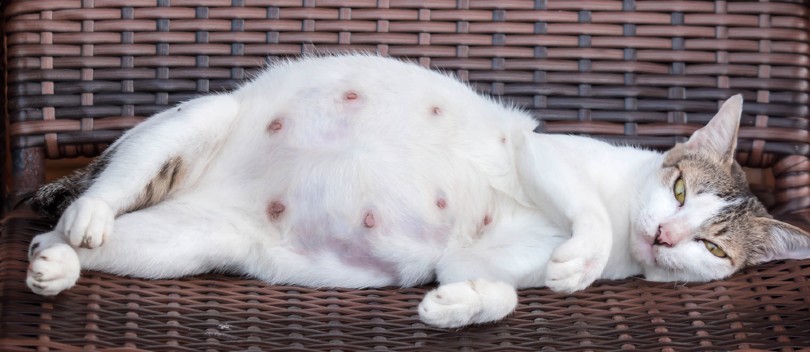
If your non-spayed female cat’s weight gain seems to be going steadily, chances are she’s pregnant rather than gaining excessive weight. Typically, weight tends to creep on a cat so slowly that you practically don’t notice until your cat is a little too plump.
- End of heat cycle: This should be one of the earlier signs of pregnancy. Many cats can go into heat every 2 to 3 weeks, so if you notice your cat is no longer entering her heat cycles, there’s a good chance she’s pregnant.
- Weight gain: This weight gain is manifested by an enlarged belly. Pregnant queens (this is the name given to pregnant female cats) will gradually gain about 2–4 pounds throughout the pregnancy. Pregnant queens (this is the name given to pregnant female cats) will gain about 2–4 pounds throughout the pregnancy, but the weight gain should be noticeable in just a few weeks. Pregnant queens (this is the name given to pregnant female cats) will gain about 2–4 pounds throughout the pregnancy, but the weight gain should be noticeable in just a few weeks.
- Change in nipples: Other than weight gain, the change in your cat’s nipples is one of the first signs of a pregnant cat. The queen’s nipples start to swell and become a darker pink color. This is also known as “pinking-up.” This process can occur about 3 weeks into the pregnancy.
- Changes in appetite: Just like us, a queen will have an increase in appetite, usually towards the end of her pregnancy, as she’s eating for herself and a bunch of kittens! However, she might also experience a kind of morning sickness, so she might also lose her appetite at this time. This is normal, but see your vet if it seems too frequent or goes on for too long.
- Enlarged Abdomen: Around 5 weeks into the pregnancy, the queen’s abdomen will begin to swell and become much more noticeably larger. This will continue until it’s time for her to give birth.
Another way to tell the difference between a fat and a pregnant cat is by looking at her from above and the side. While looking straight down at her, a pregnant cat’s belly will start to look larger, more than halfway from her neck to her tail. Looking at her from the side, you should notice that her tummy is round and bulging. A fat cat will look plump all over, not just around her belly.
Changes in Temperament During Pregnancy
Sometimes queens will start to behave differently from what you usually expect.
- Frequent sleeping: You will probably notice your cat sleeping more frequently and for more hours over the day.
- Affectionate: Many queens become much more affectionate than usual and will spend lots of time trying to gain your love and attention.
- Reclusive: This personality change isn’t very common, but some cats might become more reclusive and spend more time hiding and sleeping.
- Nesting: This behavior is normally seen just a couple of weeks before labor. Your cat may pick a hidden spot and start to spend time there. She may even drag in soft items to make it nice and cozy.
What Your Vet Will Do
You might not necessarily need your vet to confirm the pregnancy if you’ve observed most of these signs, but it’s essential to have her checked out by the vet as soon as you notice.
- Feeling the belly: Your vet might very gently palpate your cat’s belly. If your cat is halfway through her pregnancy (approximately on days 25–30), your vet might be able to detect the fetuses; however, this isn’t a reliable way to confirm pregnancy.
- Ultrasound: An ultrasound is the preferred method to confirm your cat’s pregnancy after the second or third week and is the only way to assess the fetuses’ heartbeats and, therefore their state of health.
- X-rays: About 42 days into the pregnancy, the vet can run X-rays, which can help determine how many kittens are expected. Having said that, it’s usually recommended to wait until the 55th day. This is usually only performed if your vet needs to determine litter size for any reason.
You’ll need to decide between caring for your pregnant cat and ensuring the kittens will all go to responsible and loving homes if that’s the road you decide to go down.
But if this is an unexpected pregnancy, you might want to consider having your cat spayed if you’re not planning on becoming a breeder.
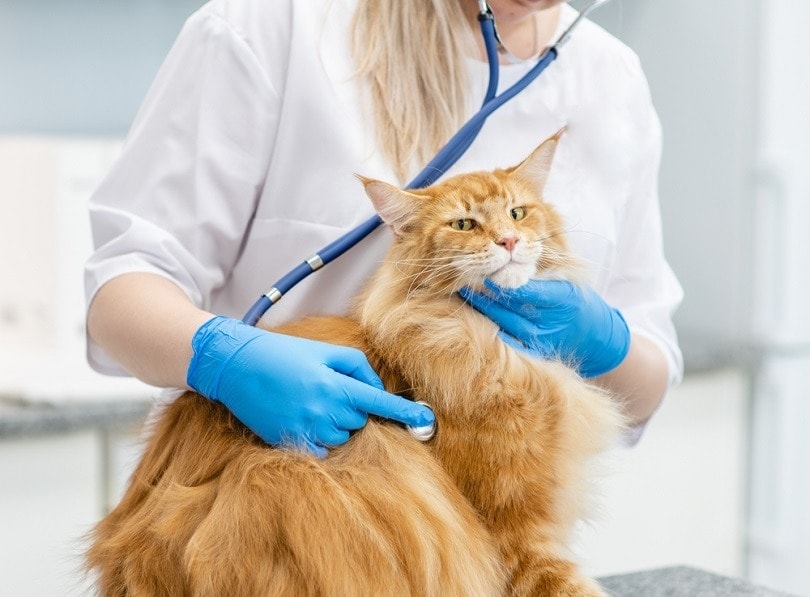
Taking Care of a Pregnant Cat
Pregnancy for a cat lasts for 58 to 67 days, and you’ll want to make your queen’s pregnancy as easy and stress-free as possible. Start by giving her any attention and affection she’s looking for but be gentle when you physically handle her, particularly with her belly.
Keep her litter box clean—scoop at least once or twice a day and ensure she can get in and out of the box without any trouble.
Nutrition
Just like for any pregnant female, nutrition is doubly important. You’ll want to ensure your cat is getting enough high-quality food and that she doesn’t lose any weight. You’ll not want to overfeed or underfeed her.
The food should be high in calories. Your best bet is to feed the queen food specifically made for pregnant and lactating cats, or even diets for kittens will also work. You will be feeding this food through her lactation period as well. She should be given smaller meals more frequently throughout the day.
Speak to your vet about the kind of food you should feed your cat and how much she should be eating, particularly as the pregnancy progresses.
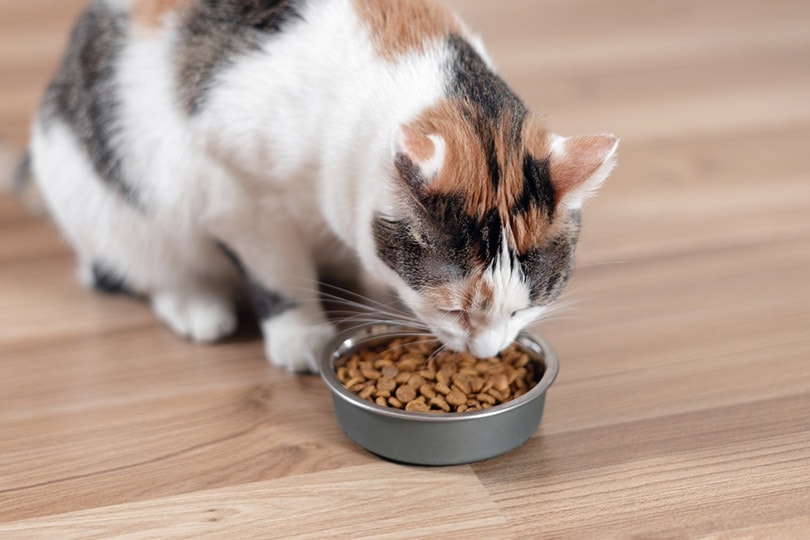
Preparing for Birth
There are definite signs that a queen is getting ready for birth. It’s best to have a nesting spot prepared for her, but otherwise, you should leave her alone and just observe from a distance. You can set up a box lined with paper and old blankets and towels in a quiet corner a few weeks before her due date. She might reject it, so try to place the box in a spot that she seems to be gravitating to, but in the long run, if your cat wants to give birth in the laundry basket, then that’s where it will happen.
The two main factors that will tell you that the kittens are on their way are a decrease in appetite and a drop in their body temperature. Usually, about 12–36 hours before they are going to give birth, queens will stop eating, and their temperature will drop to below 100°F (or 37.8ºC).
She’ll also appear quite restless and will be pacing and vocalizing more than usual. As labor approaches, you’ll probably also notice the queen licking her vulva to clean up a little clear discharge. And then it’s kitten time!
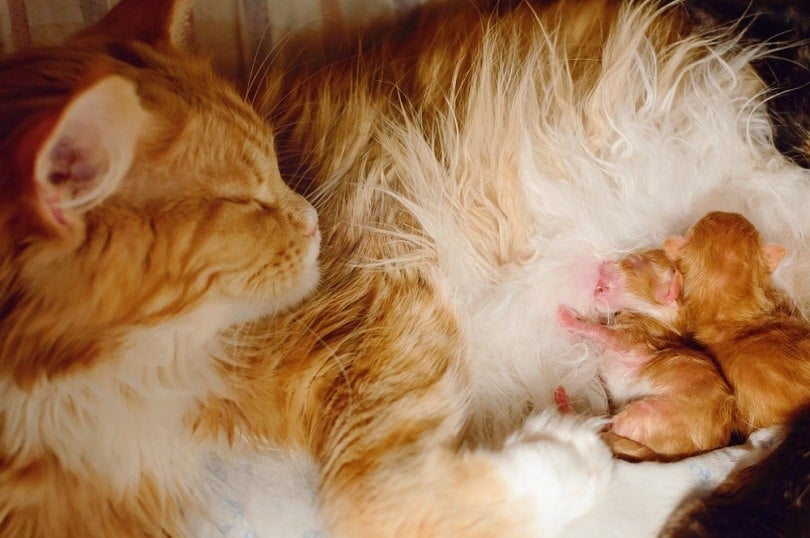
Conclusion
It can be hard to tell if your cat is starting to pack on a few pounds or is pregnant. Either way, spaying your cat has great benefits; spaying can reduce the risk of some health issues, such as cancer and uterine infections, and she won’t come in heat any longer.
Having your pregnant cat spayed is possible and routinely done in some practices, but the earlier, the better. Speak to your vet to know your options for pregnancy termination. They will help you make the right decision for you and your cat. A single cat can on average breed eight to twelve kittens every year, and according to the ASPCA, 3.2 million cats are surrendered to a shelter every year.
If your cat is indeed pregnant, hopefully, everything goes smoothly. On the other hand, if your cat is just chubby, speak to your vet about diet and exercise.
You might be interested:
- Do Cats Like to Be Kissed? Do They Understand Kisses?
- Why Do Cats Roll Around on Their Backs? 5 Typical Reasons
Featured Image Credit: Andreas Almstedt, Pixabay






